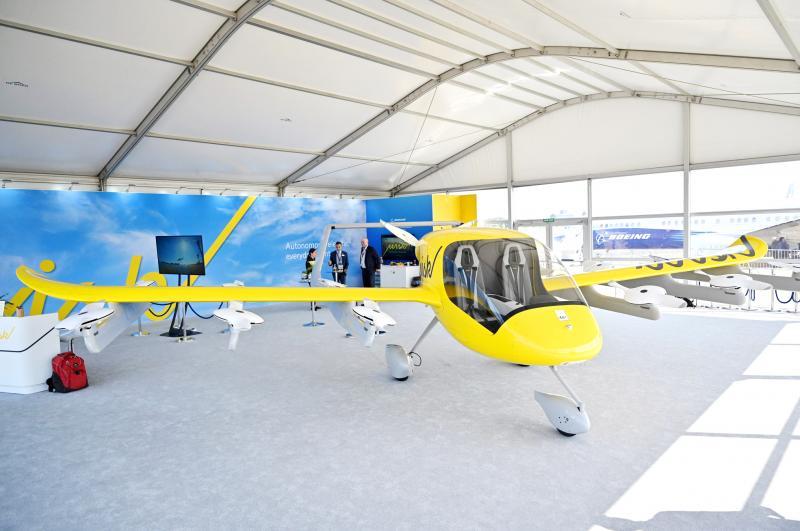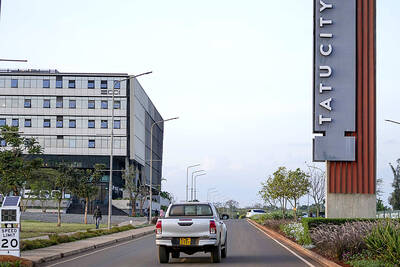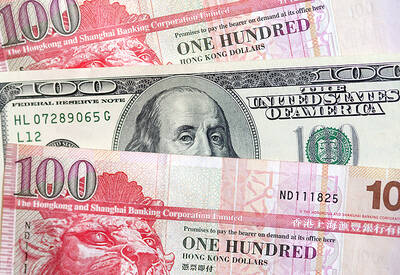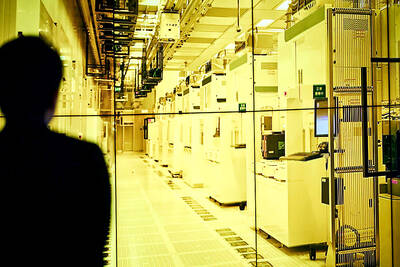One prototype air taxi suffered a software glitch, lost control and nosed into a field. Another’s computer erroneously thought it was on the ground, shutting off power in flight and plunging it into the pavement. Batteries on two more burst into flames.
The race to develop a new family of flying machines to whisk people and cargo across traffic-choked cities has drawn billions of US dollars of investment and vast promise, but some of the biggest names in aviation have had accidents during testing,a Bloomberg review of reports dating back to 2018 showed.
They include Boeing Co and its subsidiary, Aurora Flight Sciences Corp, Textron Inc’s Bell helicopter division, billionaire Larry Page’s Kitty Hawk Corp, Joby Aviation Inc and German air-taxi pioneer Lilium NV.

Photo: AFP
No one has died or been injured, and advocates say accidents are a healthy sign that the industry is pushing the envelope.
However, the new electric vertical take-off and landing vehicles (eVTOLs) use innovative technologies that have not been tested in routine service, and some safety experts say this means that the road to government approval and public acceptance is unlikely to be an easy one.
The US Federal Aviation Administration (FAA) is preparing to certify a handful of the new aircraft to carry people as soon as 2024.
Acting FAA Administrator Billy Nolen last month said in a speech that the agency is on track to meet that goal, but the timing would be dictated by the safety of the new designs.
“This is harder than people generally understand,” said John Hansman, a professor of aeronautics at the Massachusetts Institute of Technology who coauthored a paper on the challenges facing eVTOLs. “You’re pushing the state of the art in multiple dimensions at the same time.”
Hansman is also an adviser to Electra.aero Inc, which is developing a hybrid electric plane.
LEARNING EXPERIENCES
One of the most high-profile crashes occurred on Feb. 16 in a remote testing facility near Jolon, California. A physical component on Joby’s six-propeller craft broke in midair, three people familiar with the incident told Bloomberg.
The crash might not threaten the company’s long-term plans because the aircraft was operating at speeds far higher than the maximum 322kph it would fly in service, two of the people said.
A flight track by the Web site ADSBexchange.com LLC showed that it was traveling at 439kph before it disappeared.
Joby declined to comment.
The US National Transportation Safety Board (NTSB), which has not completed its investigation, has only said the aircraft suffered an unspecified component failure.
Boeing had two crashes in 2019: Aurora’s prototype air taxi on June 4, and the company’s experimental, pilotless cargo aircraft on June 21.
Aurora’s was caused by a computer’s erroneous command to shut engines and Boeing’s was due to gusty winds, the NTSB said.
“We gained valuable knowledge and experience that will benefit programs across the company,” Boeing said in an e-mailed statement.
The company is continuing its development work in a partnership with Kitty Hawk known as Wisk Aero LLC.
MANAGING MISHAPS
The accidents should not be viewed as comparable to the rare mishaps during flight testing of traditional aircraft, said Walter Desrosier, vice president for engineering and maintenance at the General Aviation Manufacturers Association trade group.
Significantly greater protections are taken in advance of test flights where pilots and engineers are going to be aboard, Desrosier said.
“When we have the ability to test things without humans, you can do additional things because you can manage the risks,” he said.
All but one of the nine accidents reviewed involved craft being flown remotely.
Kitty Hawk’s Heaviside2 crashed in a field in California near Tres Pinos, California, on Oct. 17, 2019, after a software error led to control problems, an NTSB report said. A remote pilot attempted to land the hybrid aircraft designed to carry one person, but it was not capable of touching down in a field while moving forward and suffered substantial damage, the NTSB said.
The company told investigators it was revising the software and also changing its procedures.
Kitty Hawk did not respond to requests for comment.
Similar failures of software or aircraft structures have occurred during development of human-carrying craft, but go unnoticed because they occur in a lab, not during a flight, Desrosier said.
Unlike crashes, such failures mostly are not publicly reported.
FIRE HAZARDS
The crashes and incidents involving these new-age aircraft have occurred for a variety of reasons, from failures in carbon-fiber structures to breakdowns in computer-human interactions. They highlight some of the design challenges with the technology.
Century-old flight controls used by traditional aircraft are being replaced in some cases by computerized motors, and while some initial models would be guided by traditional pilots, the goal is to transition to robotic flight.
Instead of liquid fuels, they would be powered by lithium-based batteries, creating new questions about fire hazards and ensuring an adequate charge.
A Jan. 22, 2020, fire destroyed a prototype of Eviation Aircraft Ltd’s electric-powered, nine-passenger commuter plane in Prescott, Arizona.
The fire started in a ground-based battery that is not part of the plane’s main power pack, the company said in an e-mail.
“We learned a valuable lesson from the event,” the company said in an e-mailed statement, adding that it has taken multiple steps to protect the lithium-based batteries from overheating and fire.
Similarly, Lilium, which is designing an aircraft that uses electric-powered jet engines to take off vertically, said in an e-mailed statement that it had upgraded safety measures in its battery system after a fire on Feb. 27, 2020, at an airport near Munich.
FUTURE BETS
The accidents have not stopped established companies from clamoring to invest in air-taxi start-ups or to order still-uncertified aircraft. Package shipping kingpins FedEx Corp and United Parcel Service Inc have linked up with eVTOL startups and major airlines — including American Airlines Group Inc and United Airlines Holdings Inc — also have placed bets on the industry.
However, a May report by the US Government Accountability Office on the prospects of electric-powered air taxis said one of the biggest challenges facing the industry and regulators is ensuring buy-in from the public.
“Acceptance of large numbers operating in close proximity to people and buildings will require a concerted effort on the part of industry and government to show these aircraft’s safety by demonstrating safe, reliable operations,” the report said.

To many, Tatu City on the outskirts of Nairobi looks like a success. The first city entirely built by a private company to be operational in east Africa, with about 25,000 people living and working there, it accounts for about two-thirds of all foreign investment in Kenya. Its low-tax status has attracted more than 100 businesses including Heineken, coffee brand Dormans, and the biggest call-center and cold-chain transport firms in the region. However, to some local politicians, Tatu City has looked more like a target for extortion. A parade of governors have demanded land worth millions of dollars in exchange

Hong Kong authorities ramped up sales of the local dollar as the greenback’s slide threatened the foreign-exchange peg. The Hong Kong Monetary Authority (HKMA) sold a record HK$60.5 billion (US$7.8 billion) of the city’s currency, according to an alert sent on its Bloomberg page yesterday in Asia, after it tested the upper end of its trading band. That added to the HK$56.1 billion of sales versus the greenback since Friday. The rapid intervention signals efforts from the city’s authorities to limit the local currency’s moves within its HK$7.75 to HK$7.85 per US dollar trading band. Heavy sales of the local dollar by

Taiwan Semiconductor Manufacturing Co’s (TSMC, 台積電) revenue jumped 48 percent last month, underscoring how electronics firms scrambled to acquire essential components before global tariffs took effect. The main chipmaker for Apple Inc and Nvidia Corp reported monthly sales of NT$349.6 billion (US$11.6 billion). That compares with the average analysts’ estimate for a 38 percent rise in second-quarter revenue. US President Donald Trump’s trade war is prompting economists to retool GDP forecasts worldwide, casting doubt over the outlook for everything from iPhone demand to computing and datacenter construction. However, TSMC — a barometer for global tech spending given its central role in the

An Indonesian animated movie is smashing regional box office records and could be set for wider success as it prepares to open beyond the Southeast Asian archipelago’s silver screens. Jumbo — a film based on the adventures of main character, Don, a large orphaned Indonesian boy facing bullying at school — last month became the highest-grossing Southeast Asian animated film, raking in more than US$8 million. Released at the end of March to coincide with the Eid holidays after the Islamic fasting month of Ramadan, the movie has hit 8 million ticket sales, the third-highest in Indonesian cinema history, Film